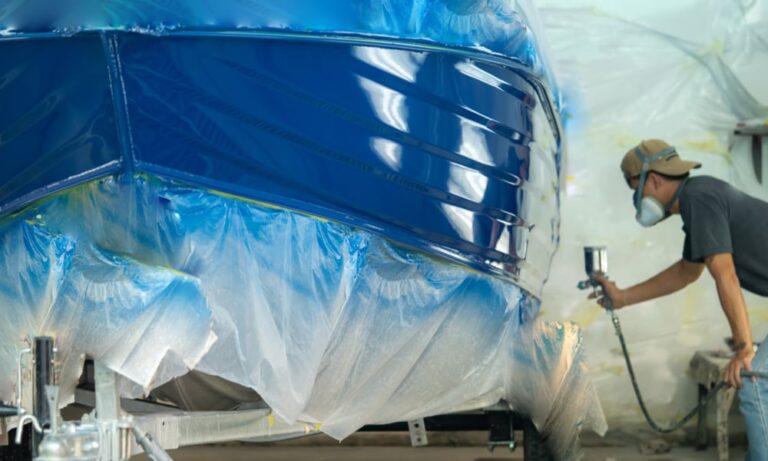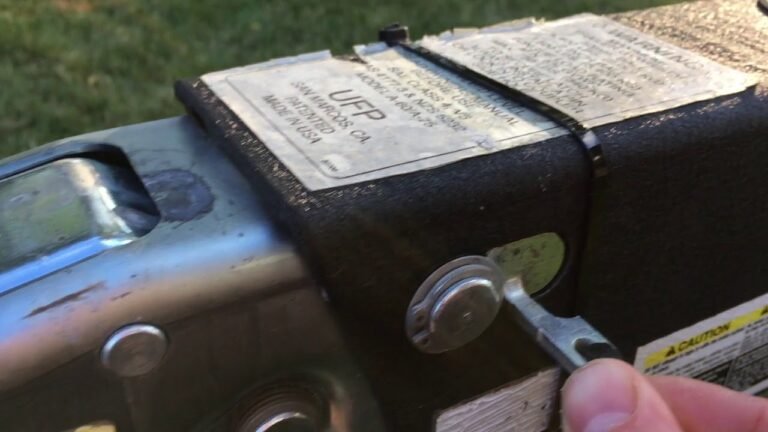How to Mount a Transducer on an Aluminum Boat | Installation Guide 2025
There are three main ways to mount a transducer on an aluminum boat: through the hull, inside the hull, or transom mounted. Mounting the transducer through the hull is ideal because it doesn’t require any holes be drilled into the boat. To do this, you’ll need a special epoxy designed for bonding to aluminum.
You’ll also need to make sure the area where you’re mounting the transducer is smooth and free of debris. Inside the hull mounting is similar to through-hull mounting, but you will need to drill a hole in order to route the wires. Transom mounted transducers are affixed to the back of the boat using either screws or bolts.
This method is typically used when there isn’t enough room on the hull for another type of mount. Whichever method you choose, be sure to follow all instructions carefully and consult with a professional if needed.
- Choose the location for the transducer
- The best place is usually on the hull of the boat, near the stern
- Clean the area where the transducer will be mounted with a marine grade cleaner/polish to remove any dirt, salt, or other debris
- Apply a bead of marine sealant around the perimeter of the mount base
- Affix the transducer to the hull using bolts or screws (depending on what type of mount base you are using)
- Torque down all fasteners to specifications provided by the manufacturer
- Run wiring from transducer to fish finder unit, making sure to route wires away from areas that could see excessive heat or movement (such as engine compartments)
- 7 Fill in any gaps between mount base and hull with marine sealant and allow to cure according to manufacturer’s instructions
Mounting Lowrance Transducer on Aluminum Boat
If you’re an aluminum boat owner, you know that one of the trickiest parts of installing electronic is finding a way to mount everything securely. Transducers are no exception – it can be tough to find a place to install them on an aluminum boat without drillings or other damage. But never fear!
With a little bit of creativity and the right supplies, you can easily and securely install your Lowrance transducer on your aluminum boat. Here’s how:
1. Choose the location for your transducer carefully.
You’ll want to avoid any areas where there might be structural damage or where the signal could be obstructed.
2. Clean the area where you’ll be mounting the transducer with rubbing alcohol to make sure there’s no dirt or debris that could prevent proper adhesion.
3. Cut a piece of marine-grade adhesive tape slightly larger than your transducer baseplate.
Peel off the backing and adhere it to the center of the chosen location on your hull.
4. Position your transducer onto the adhesive tape, making sure it’s level, then press down firmly to secure it in place.
5. That’s it!
Your Lowrance transducer is now mounted securely on your aluminum boat – no drilling required!
Mounting Garmin Transducer on Aluminum Boat
If you’re an angler who loves to fish from an aluminum boat, you know that one of the most important pieces of equipment you need is a good transducer. A transducer helps you find fish by sending sound waves through the water and then translating those waves into images on your fish finder.
There are a few different ways to mount a transducer onto an aluminum boat, but one of the best methods is to use suction cups.
Suction cups create a strong bond between the transducer and the hull of your boat, which helps to ensure that your transducer stays in place no matter what kind of conditions you’re fishing in. Plus, suction cups are relatively easy to install and remove, so you can take your transducer with you if you ever decide to switch boats.
To install suction cup-style transducers on an aluminum boat, start by cleaning the area where the transducer will be mounted with alcohol or another type of solvent.
Next, apply a generous amount of silicone sealant or marine adhesive around the edge of the suction cup base. Be sure to avoid getting any sealant or adhesive on the center part of the suction cup, as this could prevent it from forming a strong bond. Finally, press the suction cup firmly onto the hull of your boat and wait for it to dry completely before using your fish finder.
No Drill Transducer Mount
No Drill Transducer Mount
If you’re looking for a way to mount your transducer without drilling into your hull, the No Drill Transducer Mount is the perfect solution. This mount attaches to your hull with suction cups and features a swivel base so you can adjust the angle of your transducer.
It’s also easy to install and remove, making it ideal for use with different boats.
Humminbird Replacement Transducer Mount
If you’re an avid fisherman, then you know how important it is to have a good transducer mount. A transducer helps you see under the water, so you can find the best fishing spots and avoid obstacles. If your transducer mount breaks or wears out, it can be a major pain to replace it.
That’s why we’ve put together this guide on Humminbird replacement transducer mounts.
There are a few things to keep in mind when shopping for a replacement transducer mount. First, you’ll need to know the make and model of your Humminbird fishfinder.
This information can usually be found on the back of the unit. Next, take a look at the existing mount and note any special features or attachments that may need to be replaced as well. Finally, measure the distance between the holes on your fishfinder so you can get an accurate replacement mount.
Once you have all of this information, you’re ready to start shopping! There are many different types of Humminbird replacement transducer mounts available online and in stores. We recommend checking out Amazon or Bass Pro Shops for a wide selection and great prices.
Be sure to compare several options before making your final decision – there’s nothing worse than being stuck with a bad mount!
We hope this guide has been helpful in your search for a new Humminbird transducer mount. Happy fishing!
Stern Saver
If you are looking for a way to save money on your energy bill, Stern Saver may be the answer. This unique product is designed to help you reduce the amount of energy you use by up to 30%. It does this by using a combination of solar power and wind power to generate electricity.
The electricity is then used to run an air conditioner, which in turn cools your home.
The Stern Saver is easy to install and can be done by anyone with basic do-it-yourself skills. It comes with all the necessary hardware and instructions.
Once installed, it requires no maintenance or upkeep. Best of all, it comes with a money back guarantee so you have nothing to lose!

Credit: www.youtube.com
Can I Mount a Transducer Inside the Hull of an Aluminum Boat?
Yes, you can mount a transducer inside the hull of an aluminum boat. However, there are a few things to keep in mind when doing so. First, the thickness of the hull will affect how well the transducer transmits and receives signals.
Thinner hulls will allow for better transmission and reception than thicker hulls. Second, the shape of the hull will also affect signal strength. A boat with a more streamlined hull (such as a V-shaped Hull) will have less interference from the sides of the hull than a square-shaped Hull.
Finally, it is important to make sure that the transducer is mounted securely to avoid any movement or vibration that could damage it.
Where Do You Mount a Lowrance Transducer on an Aluminum Boat?
If you’re looking to mount a Lowrance transducer on an aluminum boat, there are a few things you’ll need to take into account. First, you’ll need to decide where on the boat you want to mount the transducer. Keep in mind that the transducer needs to be mounted in an area where it will not come into contact with any metal objects, as this can interfere with its performance.
You’ll also want to make sure that the location you choose is free of any debris or other objects that could damage the transducer. Once you’ve chosen a location, use marine-grade epoxy to attach the mounting bracket for the transducer to the hull of the boat. Then, follow the instructions provided by Lowrance to install the transducer itself.
How Do You Position a Boat Transducer?
There are a few things to keep in mind when positioning your boat transducer. The first is that the transducer needs to be mounted as close to the bottom of the hull as possible. This ensures that it will be able to pick up signals from the bottom and not be obstructed by anything else in the water.
Secondly, the transducer should be mounted in a location where there is minimal turbulence. This means avoiding areas where waves are breaking or where there is a lot of boat traffic. Lastly, it is important to make sure that the transducer is level so that it can function properly.
If you follow these guidelines, you should have no trouble getting accurate readings from your transducer.
Should Transducer Be Flush With Bottom of Boat?
No definitive answer exists to this question since it really depends on the type and size of the transducer being used, as well as the specific application. However, in general, it is generally recommended that transducers be flush with the bottom of the boat in order to avoid potential interference issues and maximize performance.
How To Install a Transducer on a Jon Boat Aluminum Boat – Garmin Bass Boat Build
Conclusion
If you’re looking to install a transducer on your aluminum boat, there are a few things you’ll need to take into consideration. First, you’ll need to determine the best location for the transducer. Once you’ve done that, you’ll need to drill a hole in the hull of the boat and seal it properly.
Finally, you’ll need to attach the transducer itself and run the wiring through the hull. By following these simple steps, you can easily install a transducer on your aluminum boat.



